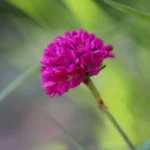While the Madagascar periwinkle is typically cultivated as an annual in regions with cold winters, it is, in fact, a tender perennial native to tropical climates. This means it is possible to keep the plant alive through the winter months by bringing it indoors, allowing you to preserve a particularly beautiful specimen or get a head start on the next growing season. The process of overwintering requires a dedicated effort to transition the plant from its outdoor environment to the very different conditions found inside a home. Success hinges on preparing the plant correctly in the autumn, providing the right indoor care, and carefully re-acclimatizing it to the outdoors the following spring. It is a rewarding process for the dedicated gardener who wishes to extend the life of this vibrant plant beyond a single season.
The decision to overwinter should be made before the first frost threatens, as the plant is highly sensitive to cold and can be damaged by even a light frost. The goal during the winter is not to encourage active growth or flowering, but rather to keep the plant in a state of semi-dormancy, alive and healthy until it can be returned outdoors. Expecting the plant to perform as it did during the summer is unrealistic; the lower light levels and dry indoor air of a typical home environment are far from its ideal growing conditions. The focus should be purely on survival.
Not every plant is a good candidate for overwintering. It is best to select your healthiest, most vigorous, and most compact plants for this purpose. Avoid choosing any plant that shows signs of disease or a heavy pest infestation, as these problems will only be magnified indoors and can potentially spread to your other houseplants. A healthy plant has the energy reserves needed to withstand the stress of the transition and the suboptimal conditions of the winter months. Starting with a strong specimen significantly increases your chances of success.
The overwintering process can be approached in two primary ways: you can either bring the entire potted plant indoors, or you can take cuttings from the parent plant in late summer and root them indoors over the winter. Taking cuttings is often a more manageable approach, as it requires less space and you start with small, fresh plants that are free of any soil-borne pests from the garden. Both methods can be successful, and the choice often depends on the gardener’s available space and preference.
Preparing the plant for indoors
The preparation for moving a Madagascar periwinkle indoors should begin a couple of weeks before the anticipated move. If your plant is growing in a garden bed, it will need to be carefully dug up and potted into a container with fresh, sterile potting mix. Try to retain as much of the root ball as possible to minimize shock. Choose a pot that is just large enough to accommodate the root system, as an oversized pot can hold too much moisture and increase the risk of root rot. For plants already in containers, this is a good opportunity to check if they are root-bound and repot if necessary.
More articles on this topic
Before bringing the plant inside, it is crucial to inspect it thoroughly for any pests. Check the stems, the tops and undersides of the leaves, and the soil surface for common pests like aphids, spider mites, and whiteflies. It is a very good practice to treat the plant preventatively to avoid bringing an infestation into your home. You can do this by spraying the entire plant, including the leaf undersides, with insecticidal soap or neem oil. Repeat this treatment a week later to ensure you have eliminated both adult insects and any newly hatched eggs.
Pruning the plant before it comes indoors is also a highly recommended step. Cut back the entire plant by about one-half to two-thirds of its size. This may seem drastic, but it serves several important purposes. It makes the plant more compact and manageable for an indoor space, removes any remaining flowers and leggy growth, and reduces the amount of foliage the stressed root system has to support during the transition. This hard pruning encourages the plant to conserve its energy for survival rather than continued growth.
Finally, the plant needs to be gradually acclimated to the lower light conditions it will experience indoors. This process, often called hardening off in reverse, helps to reduce the shock of the transition. Start by moving the plant from its full-sun location to a spot with partial shade for a few days. Then, move it to a location with even more shade, such as a covered porch, for another few days. This slow and steady reduction in light exposure helps the plant’s foliage adjust and minimizes the leaf drop that often occurs when a plant is moved indoors abruptly.
Indoor care during winter
Once inside, the overwintering Madagascar periwinkle requires a significant shift in its care routine. The most critical factor for its survival is providing it with as much light as possible. Place the plant in the sunniest window you have, which is typically a south-facing one. The intensity and duration of natural light are much lower during the winter, so maximizing its exposure is paramount. If you do not have a location with sufficient natural light, you may need to supplement with a fluorescent grow light for 12 to 14 hours per day to keep the plant healthy.
More articles on this topic
Watering must be drastically reduced during the winter months. Since the plant is not in a state of active growth, its water needs are minimal. Overwatering is the single most common reason that overwintered plants fail. Allow the soil to dry out almost completely between waterings. Check the soil moisture by inserting your finger a few centimetres deep; only water when it feels dry. When you do water, provide just enough to moisten the soil, and ensure that the pot has good drainage so that no water is left standing in the saucer.
During the overwintering period, you should not fertilize the plant at all. Fertilizer encourages new growth, which is not the goal during this semi-dormant phase. The new growth that would be produced in the low-light conditions of winter would be weak, pale, and leggy, which only drains the plant’s energy reserves. You can resume fertilization in the spring when you see signs of new, active growth and are preparing to move the plant back outdoors.
Maintain a cool but not cold temperature for the plant. An ideal temperature range for overwintering is between 13 and 18 degrees Celsius. Avoid placing the plant near heat sources like radiators or vents, as the hot, dry air can be very stressful for it. Also, keep it away from cold, drafty windows. The plant may drop some of its leaves after being brought indoors; this is a normal reaction to the change in environment and is not necessarily a cause for alarm as long as the stems remain firm and healthy.
Reintroducing the plant to the outdoors
The process of moving the overwintered Madagascar periwinkle back outdoors in the spring is just as critical as bringing it inside in the autumn and must be done gradually. Do not make the mistake of moving the plant directly from your home into full sun. The foliage that has grown indoors is not adapted to the intensity of direct sunlight and will get severely sunburned. This process of re-acclimatization, or hardening off, should take place over a period of one to two weeks.
Begin the hardening-off process once all danger of frost has passed and night-time temperatures are consistently staying above 13 degrees Celsius. Start by placing the plant outdoors in a shady, protected location for just an hour or two on the first day. The next day, leave it out for a few more hours, still in the shade. Gradually, over the course of the week, increase the amount of time the plant spends outside each day.
After about a week of being in the shade, you can begin to introduce the plant to short periods of direct morning sun, which is less intense than the afternoon sun. Start with about an hour of direct sun and slowly increase the duration of sun exposure by an hour or so each day. Continue this process for another week, carefully monitoring the plant for any signs of stress, such as wilting or scorched leaves. If you see any signs of stress, move it back into the shade and proceed more slowly.
Once the plant has been fully hardened off and can tolerate a full day of sun without wilting, it is ready to be transplanted into its final summer location, whether that is a garden bed or a larger decorative container. At this time, you can give it a light trim to shape it and encourage bushy new growth. Begin a regular watering and fertilizing schedule to support its transition back into active growth and flowering. With proper care, your overwintered plant will soon reward you with a profusion of beautiful blooms.
An alternative: overwintering cuttings
For many gardeners, overwintering cuttings is a more practical alternative to bringing a full-sized plant indoors. This method saves space and reduces the risk of transferring soil-borne pests or diseases into your home. In late summer, while the parent plant is still healthy and vigorous, take several 8 to 10-centimetre stem cuttings from non-flowering shoots. Use a clean, sharp blade and make your cut just below a leaf node.
Prepare the cuttings by removing the leaves from the bottom half of the stem. Dip the cut end into a rooting hormone to encourage faster and more reliable root development. Plant each cutting in a small pot filled with a moist, sterile rooting medium like a mix of peat moss and perlite. Place the pots in a warm location with bright, indirect light. To maintain high humidity, you can cover the pots with a clear plastic bag, making sure the bag does not touch the leaves.
The cuttings should develop roots within three to four weeks. Once they are well-rooted and showing signs of new growth, you can remove the plastic covers and care for them as small houseplants. Place them in a sunny window and water them when the top layer of soil feels dry. Because they are actively, albeit slowly, growing, they will require more consistent watering than a dormant, full-sized plant would.
In the spring, once the danger of frost has passed, you can begin the process of hardening off these new young plants to acclimate them to outdoor conditions. This process is the same as for a full-sized overwintered plant, involving a gradual increase in their exposure to sun and wind over a one to two-week period. Once fully hardened off, these new plants, which are exact clones of the parent, can be planted out in the garden to provide a beautiful display all summer long.

















